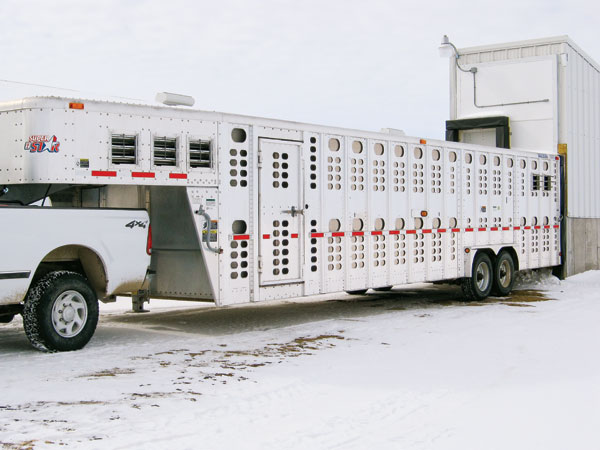Taking a System PRRS Negative
The Pipestone System, consisting of 140,000 sows, is cleaning up porcine reproductive and respiratory syndrome (PRRS), establishing PRRS-negative breeding stock and eliminating the resident virus in infected breeding herds.

Every farm is only 250 days away from PRRS-free production,” states Joel Nerem, DVM, director of health, Pipestone (MN) Veterinary Clinic and Pipestone System.
The Pipestone System, consisting of 140,000 sows, is cleaning up porcine reproductive and respiratory syndrome (PRRS), establishing PRRS-negative breeding stock and eliminating the resident virus in infected breeding herds.
In order to complete this process, the gilt development unit (GDU) is loaded and closed following one-time exposure of the gilt pool to a field-strain virus. The GDU is then closed to naïve gilt entries until PRRS virus has been eliminated, Nerem explained in a talk at the Leman Swine Conference.
The Pipestone System began the PRRS virus elimination plan in 2011. The process is critical to reducing disease costs, 88% of which take place in the wean-to-finish period. It’s paramount to maintaining pig well-being and animal welfare, improving farm staff working conditions and meeting responsibilities to shareholders/producers who finish out the pigs.
Tough Job Ahead
But keeping the virus out after the farms have been cleaned up represents a daunting task. To that end, Nerem and his staff are enforcing a standard application of tough biosecurity protocols to limit mechanical and aerosol transfer of the virus. Steps involve creating biosecurity checklists for the farms that include identification of transportation risks and application of protocols, training, audits and testing.
To prevent mechanical transmission, disease prevention focuses on incoming materials and people. Five critical control points include:
All staff must shower in and shower out of facilities.
Incoming materials must be disinfected, inspected and meet required downtime.
All farms must monitor load-in, load-out sites.
To block mechanical transfer, all incoming objects and people are monitored.
Pass-through windows are limited to only food for employees.
“We take a dirty/clean line approach to barn entrance, meaning footwear must be removed on the dirty side of the barn entrance that is separated by a bench before crossing over to the clean side of the barn to shower in,” Nerem says.
“There is mandatory biosecurity protocol testing for all farm staff every month. A health technician visits every farm and conducts a random biosecurity audit and gives staff a quiz that include questions, such as how many PRRS-free days has this farm had?” he explains.
Pipestone System is applying the latest breakthroughs in PRRS transmission research to protect sow farms from new PRRS virus infections, Nerem says. All biosecurity interventions and protocols are based on research, most of which was conducted by Scott Dee, DVM, Pipestone Veterinary Clinic.
Outside vendors are monitored very carefully, including feed delivery and manure pumping, to make sure that transportation is not a risk.
Truck washing is a priority and trailers are meticulously checked for signs of PRRS virus. Drying is vital.
Trailers that haul gilts to filtered sow farms are also filtered to maintain PRRS-free status, he stresses.
Pipestone System controls PRRS aerosol spread by maintaining 100% filtered sow farms, Nerem says. Twelve filtered sow farms and three filtered boar studs are closely monitored and have remained PRRS virus-free. Boar stud filtration started five years ago. Sow farm filtration began in 2008.
“We have 16 sow farms on track to be filtered; we are committed to filtering where it fits and where PRRS and pig coexistence is a density issue,” Nerem adds.
Mapping PRRS
For production sites in Minnesota, the Pipestone System cooperates with the University of Minnesota in mapping spread of PRRS virus. Spencer Wayne, DVM, Pipestone Veterinary Clinic, focused on epidemiology and mapping as part of his PhD at the University of Minnesota. He has mapped all swine production facilities within five miles of each Pipestone System sow farm to communicate the risks of pig and PRRS density to shareholders for regional disease control.
Wayne has coordinated a regional PRRS control project in a key area for Pipestone System production. Working with many different producer groups, the project has made progress over the past 18 months. “In 2009, 85% of the farms in our region were PRRS positive; today, 85% are PRRS negative,” he notes.
Verification
“Once you establish a PRRS-negative farm, be diligent and test stock in and out and have a monthly, systematic protocol for both,” Nerem reminds. Verify PRRS-negative status in replacement gilts, boar semen and weaned pigs.
“Verify the implementation of protocols for visitors, personnel and outside contractors/vendors by taking swabs for PRRS virus at various critical control points. People and equipment will be swabbed prior to admittance. We measure our risk and provide this feedback to employees,” Nerem says. Outside vendors must sign a biosecurity contract.
“All these steps make what we do important, and make people think about where they’ve been and the importance of storing this information for reference.
“PRRS virus-free production is necessary for the good of our animals and our employees. It is the right thing to do from a profit standpoint, and we think, ethically, it is the right thing to do,” Nerem says.
“Taking a production system PRRS negative” is the Pipestone System’s goal for sow farms by 2013 and for the entire wean-to-finish production system by 2015, concludes Gordon Spronk, DVM, Pipestone Veterinary Clinic & Pipestone System.
About the Author(s)
You May Also Like





